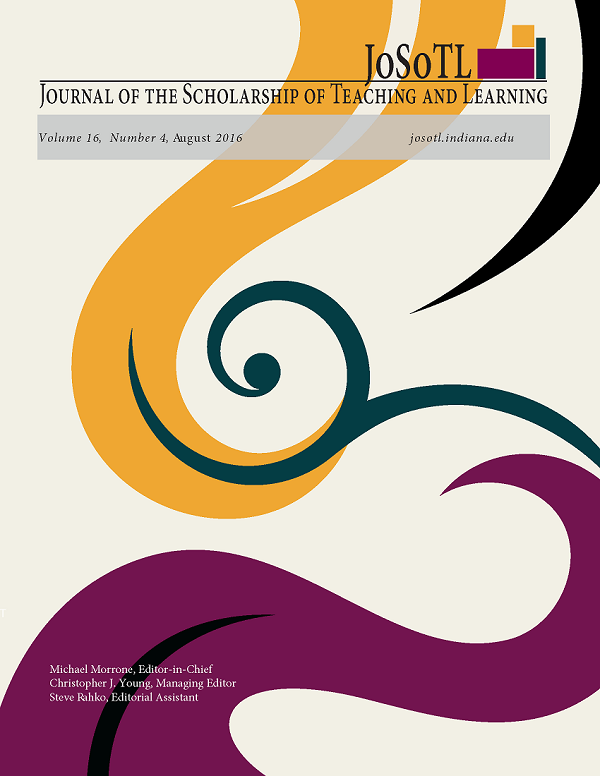You Can Lead Students to Water, but You Can't Make Them Think: An Assessment of Student Engagement and Learning through Student-Centered Teaching
Main Article Content
Abstract
Downloads
Article Details
- Authors retain copyright and grant the Journal of the Scholarship of Teaching and Learning (JoSoTL) right of first publication with the work simultaneously licensed under a Creative Commons Attribution License, (CC-BY) 4.0 International, allowing others to share the work with proper acknowledgement and citation of the work's authorship and initial publication in the Journal of the Scholarship of Teaching and Learning.
- Authors are able to enter separate, additional contractual agreements for the non-exclusive distribution of the journal's published version of the work (e.g., post it to an institutional repository or publish it in a book), with an acknowledgement of its initial publication in the Journal of the Scholarship of Teaching and Learning.
- In pursuit of manuscripts of the highest quality, multiple opportunities for mentoring, and greater reach and citation of JoSoTL publications, JoSoTL encourages authors to share their drafts to seek feedback from relevant communities unless the manuscript is already under review or in the publication queue after being accepted. In other words, to be eligible for publication in JoSoTL, manuscripts should not be shared publicly (e.g., online), while under review (after being initially submitted, or after being revised and resubmitted for reconsideration), or upon notice of acceptance and before publication. Once published, authors are strongly encouraged to share the published version widely, with an acknowledgement of its initial publication in the Journal of the Scholarship of Teaching and Learning.
References
Albers, C. (2007). Improving pedagogy through action learning and scholarship of teaching and learning. Teaching Sociology, 36:1, 79-86.
Asoodeh, M.H., Asoodeh, M.B., and Zarepour, M. (2012). The impact of student-centered learning on academic achievement and social skills. Procedia—Social and Behavioral Sciences, 46, 560-564.
Astroth, K. (1994). The trouble with gold stars, incentive plans, A’s, praise and other bribes. Journal of Extension, 32(2).
Babcock, P. (2010). Real costs of nominal grade inflation? New evidence from student course evaluations. Economic Inquiry, 48, 983-996.
Benvenuto, M. (2001). Teaching Is Learning – Maximum Incentive, Minimum Discipline in Student Groups Teaching General Chemistry. Journal of Chemical Education, 78(2), 194-197.
Briggs, L.T., Brown, S.E., Gardner, R.B., and Davidson, R.L. (2009). DRAMA: An extended conceptualization of student anxiety in criminal justice research methods courses. Journal of Criminal Justice Education, 20(3), 217-226.
Davis, J., Cronley, C., Madden, E., Kim, Y. (2014). Service-learning use in criminal justice education. Journal of Criminal Justice Education, 25(2), 157-174.
Fearon, C., McLaughlin, H., Eng, T. (2012). Using student group work in higher education to emulate professional communities of practice. Education + Training, 54:2/3, 114-125.
Felder, R.M. & Brent, R. (1996). Navigating the bumpy road to student-centered instruction. College Teaching, 44(2).
Formica, S.P.; Easley, J.L.; & Spraker, M.C. (2010). Transforming common-sense beliefs into Newtonion thinking through Just-In-Time Teaching. Physical Review Special Topics Physics Education Research, 6(2), 020106.
Fuad, M.M., & Jones, E.J. (2012). Using Extra Credit to Facilitate Extra Learning in Students. International Journal of Modern Education in Computer Science (IJMECS), 4(6), 35.
Gordon, J., Barnes, C., and Martin, K. (2009). Undergraduate research methods: does size matter? A look at the attitudes and outcomes of students in a hybrid class format versus a traditional class format. Journal of Criminal Justice Education, 20(3), 227-248.
Grant, D., & Green, W.B. (2013). Grades as incentives. Empirical Economics, 44(3), 1563-1592.
Gullo, C., Ha, T.C., and Cook, S. (2015). Twelve tips for facilitating team-based learning, Medical Teacher, 37(9), 819-824.
Haggis, T. (2009). What have we been thinking of? A critical overview of 40 years of student learning research in higher education. Studies in Higher Education, 34:4, 370-390.
Halloun, I.A., & Hestenes, D. (1985). Common sense concepts about motion. American Journal of Physics, 53(11), 1056-1065.
Hout, M., Elliott, S., and Frueh, S. (2012). Do high-stakes tests improve learning? Issues in Science and Technology, 29(1), 33-38.
Jafari, Z. (2014). A comparison of conventional lecture and team-based learning methods in terms of student learning and teaching satisfaction. Medical Journal of the Islamic Republic of Iran, 28, 5.
Judi, H.M., & Sahari, N. (2013). Student-centered learning in statistics: Analysis of systematic review. Procedia—Social and Behavioral Sciences, 103, 844-851.
Natarajan, R., & Bennett, A. (2014). Improving student learning of calculus topics via modified Just-in-Time Teaching methods. PRIMUS, 24(2), 149-159.
Novak, G.M. (2011). Just-in-Time Teaching. New directions for teaching and learning, 2011 (128), 63-73.
Oblinger, D.G., & Maruyama, M.K. (1996). Distributed Learning. Boulder, CO: Cause Professional Paper Series, #14.
Pynes, C.A. (2014). Seven arguments against extra credit. Teaching Philosophy, 37(2), 191-214.
Slunt, K.M., & Giancarlo, L.C. (2004). Student-Centered Learning: A Comparison of Two Different Methods of Instruction. Journal of Chemical Education, 81(7), 985.
Stack, S. (2007). The effect of extra credit projects on learning: a research note. Journal of Criminal justice Education, 16(2), 318-327.
Stamatel, J., Bushway, S., and Roberson, W. (2013). Shaking up criminal justice education with team-based learning. Journal of Criminal Justice Education, 24(3), 417-434.
Sundt, J. (2010). Overcoming student resistance to learning research methods: An approach based on decoding disciplinary thinking. Journal of Criminal Justice Education, 21(3), 266-284.
